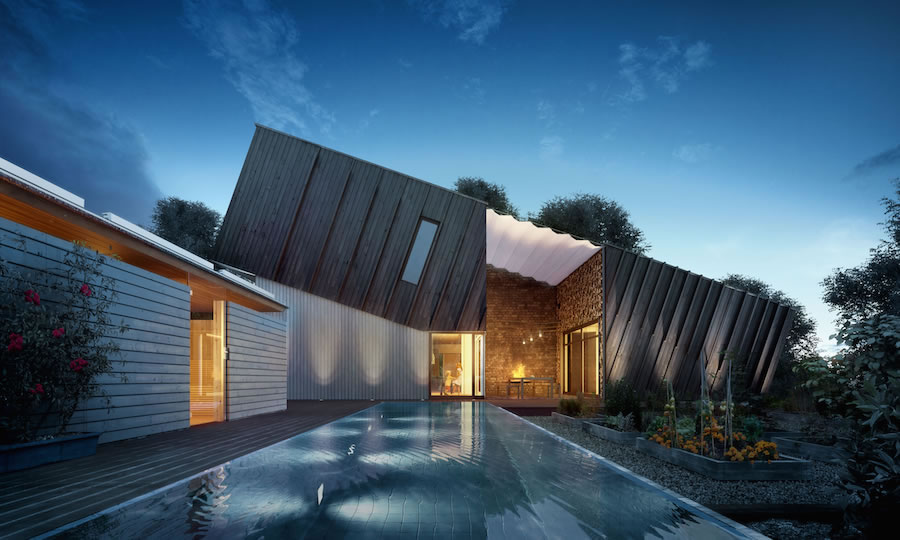As the collective consciousness of the architectural class warms to the imperative of environmental sustainability, a variety of committed organizations have in tandem devised sets of graded building standards, issuing certificates to buildings according to the level of quantified eco-friendliness achieved. It’s a trend that has freshly incentivized the industry, and as the shift toward eliminating nonrenewable energy gets more competitive, such administrative bodies have in turn been inspired to raise the bar by tightening their sets of prerequisites. The perhaps most ambitious manifestation of this move is embodied by the ZEB-OM classification, conceived by ZEB (The Research Center on Zero Emission Buildings). As the name of the entity should imply, the Norway-based ZEB seeks to expel greenhouse gases altogether from the design equation. And transnational architectural firm, Snøhetta—tightknit ZEB industry allies—alongside a multidisciplinary coterie of like minds and objectives, have brought this concept into fruition with the recent ZEB Pilot House.
The eccentric angular structure of this project is instantly awe-inspiring, hinting at strict and advanced modernist aesthetics instructing the contours of the single-family simulation, though according to Snøhetta senior architect Kristian Edwards, this transfixing appearance was predominately a utilitarian implementation. “The design is very much a product of research and function,” Edwards notes, pointing out that the steep slope of the roof, the building’s most conspicuously extraordinary feature, was pursued in the interest of optimal orientation. In collating bales of vital research information, most of which provided by the likes of the Life Cycle Assessment (LCA), Building Information Modeling (BIM) and Environmental Product Declaration (EPD), it was determined that the angle precision of the roof, bedecked with solar collectors, would maximize its solar harvest.

The steep slope of the roof, the building’s most conspicuously extraordinary feature, was pursued in the interest of optimal orientation. The outdoor atrium, also pictured here, is nestled within walls comprised of reclaimed brick and firewood.
In addition to the pronounced roof incline, there are two additional “conceptual components” exhibited by the ZEB Pilot House (also known as the Multi-Comfort House), Edwards says. One of which is the centrally located outdoor atrium, for a moment veering from the initial modernist façade in favor of a full embrace of a bucolic simplicity, in perfect harmony with the pilot house’s surrounding environment. Cozily corralled within four walls comprised of reclaimed brick and firewood, the atrium offers the serenity of outdoor dining during the temperate seasons. The other component of Edwards’ emphasis is the gabion wall structure, imposingly girding the zero-emission home at its borders, effectively commanding the privacy of its inhabitants and concealment of their passive technology interior features.
PROJECT
LOCATION Ringdalskogen, Larvik, Norway
Program Zero Emission Demonstration Building
Size 220 m 2 (house), 220 m 2 (site)
Completion 2014
Certification ZEB-OM
TEAM
CLIENT Optimera and Brødrene Dahl (Saint Gobaink)
Architect Snøhetta
Energy Specialist, SINTEF Tor Helge Dokka
Embodied Specialist, SINTEF To- rhildur Kristjansdottir
Energy Specialist, Brødrene Dahl Harald Amundsen
Technical Consultant, Optimera Halvor Kråkenes
Site Management Gjermund Kaupang
General Building Contractor Espen Stær AS
Landscape Contractor Steen Lund AS
SUPPLIERS
Windows Natre/Velux
Doors Jeld Wen
Acoustic Ceiling Tor Helge Dokka
PV Panels Innotech Solar
Electrical System Schneider Electric Ventilation System Nilan Compact P
Budding still as we are in the early stages of this paradigm transformation, a feat as lofty as a built structure that produces a net CO2 impact of precisely zero isn’t exactly a feasible solitary mission. For this reason, multiple parties with varying fields of expertise were recruited for its execution. “Ranging from material studies, insulation solutions, realistic measured energy use, to project and building processes,” Edwards says, “We were able to really extend our ambitions across the board.” The ZEB Center and Snøhetta were escorted along the way by a trusty entourage that included reputed problem-solvers SINTEF, Brødrene Dahl (“Norway’s leading heating, ventilation, and sanitation technology wholesaler”), and mammoth building materials purveyor Optimera. The results did not merely illustrate the value-neutral elimination of greenhouse gas output, but the value-positive production of clean energy as well—neatly in line with the “plus house” model. This made possible by the abovementioned abundance of solar panels and collectors, as well as in-ground geothermal “energy wells.”
For this model to succeed, however, Edwards stresses, the detail of personal comfort must not become lost or forgotten in the pursuit of supreme sustainability, however honorable. “We are clearly defeating the purpose if we ignore comfort and well-being in ZEB projects, no matter how advanced.” To complement this aspect of the project, items pertaining to air quality, materiality, daylight, and even traditional Norwegian culture influenced the design of the house tremendously. And though the ZEB Pilot House is a prototype of sorts, with framework that might appear overwhelmingly intricate at first hand, one must ponder the eventuality of this design template being further adopted and emulated by the industry as a whole. “I think on a certain scale this is slowly happening,” Edwards says of the remarkable increase in accepted responsibility among his industry peers, “and that by and large, there is a consensus within the architect community at least, that as an industry, we simply cannot conscientiously create buildings that have detrimental impact to their environment locally, and globally.”


